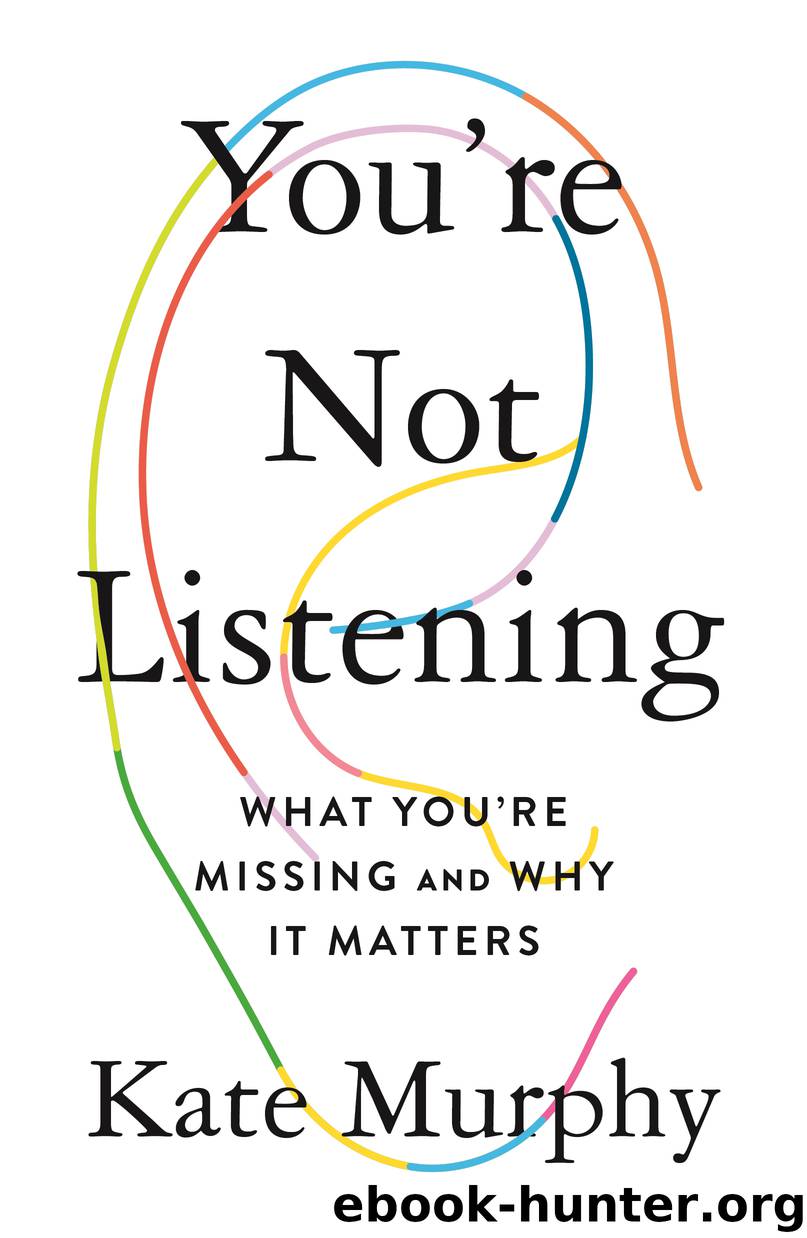You're Not Listening by Kate Murphy

Author:Kate Murphy
Language: eng
Format: epub
Publisher: Celadon Books
13
Hammers, Anvils, and Stirrups
Turning Sound Waves into Brain Waves
The passenger pickup zone at Houston’s George Bush Intercontinental Airport was pandemonium. Cops bellowed and blew whistles, diverting traffic around construction. Workers in hard hats and orange vests jackhammered concrete. A belching backhoe sent heaps of ashy rubble crashing into the bed of a rumbling dump truck. Shuttle buses idled and hissed. Cars honked. Drivers rolled down their windows and yelled expletives.
I saw my father exit the terminal about one hundred yards from where I was stuck in a line of cars. He was dragging a roller bag that roused a flock of pigeons pecking on the pavement. I stood on the running board of my car and called out, “Dad!” My voice was lost in the surrounding din. And yet, my father snapped his head in my direction. He waved and strode determinedly to the car. “You can always hear your puppies,” he said.
Certainly, there are animals that have better hearing than humans. A dog, for example, could hear its puppy yelp from a much greater distance than my dad could hear me, his grown daughter. Elephants’ hearing is so sensitive they can hear approaching clouds. But humans are particularly adept at discriminating between and categorizing sounds, and—perhaps most important—we imbue what we hear with meaning.
When my dad exited the airport, he plunged into a roiling sea of sound waves, undulating at various frequencies and amplitudes. But it was the unique sonic properties of my voice that got his attention. My voice triggered a cascade of physical, emotional, and cognitive reactions that made him take notice and respond. It’s easy to take for granted our ability to perceive and process auditory information in this way. We do it all day, every day. Nevertheless, it’s a feat that’s astounding in its specificity and complexity.
There’s been extensive research over the years on where in the brain we make sense of auditory information. The processes that underlie the recognition and interpretation of sound have been studied in a variety of species (monkeys, mice, rabbits, harpy eagles, sea lions, dogs, etc.), and you can read hundreds of papers about everything from the neural pathways auditory signals take to how your genes respond depending on the input. And yet, there’s still little understanding of just how we listen and connect with one another during a conversation. Processing what someone says, it turns out, is one of the most intricate and involved things we ask our brains to do.
What we do know is that each side of your brain has an auditory cortex, conveniently located near your ears. If it is injured or removed, you will have no awareness of sound, although you might have some reflexive reaction to it. You’ll flinch at a clap of thunder, but you won’t know why. Critical to the comprehension of speech is Wernicke’s area, located in the brain’s left hemisphere. It’s named for the German neurologist Carl Wernicke, who, in 1874, published his discovery that stroke patients with lesions in that area could still hear and speak but were unable to comprehend what was said to them.
Download
This site does not store any files on its server. We only index and link to content provided by other sites. Please contact the content providers to delete copyright contents if any and email us, we'll remove relevant links or contents immediately.
Men In Love by Nancy Friday(4320)
Everything Happens for a Reason by Kate Bowler(4067)
The Immortal Life of Henrietta Lacks by Rebecca Skloot(3826)
Why We Sleep by Matthew Walker(3771)
The Sports Rules Book by Human Kinetics(3586)
Not a Diet Book by James Smith(2724)
The Emperor of All Maladies: A Biography of Cancer by Siddhartha Mukherjee(2430)
Sapiens and Homo Deus by Yuval Noah Harari(2411)
Day by Elie Wiesel(2240)
Endless Forms Most Beautiful by Sean B. Carroll(2083)
Angels in America by Tony Kushner(2047)
A Burst of Light by Audre Lorde(1980)
Hashimoto's Protocol by Izabella Wentz PharmD(1898)
Dirty Genes by Ben Lynch(1855)
Reservoir 13 by Jon McGregor(1852)
Stretching to Stay Young by Jessica Matthews(1714)
Fat for Fuel by Joseph Mercola(1694)
The Immune System Recovery Plan by Susan Blum(1690)
Boost Your Brain Power in 60 Seconds by Michelle Schoffro Cook(1677)
